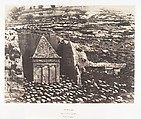Jérusalem, Vallée de Josaphat, Tombeau de Zacharie
Auguste Salzmann French
Printer Imprimerie photographique de Blanquart-Évrard, à Lille French
Not on view
Salzmann’s photographs were widely considered to be "the rigorous translation of nature herself," free of human intervention. A common conception of photography in the mid-nineteenth century, this idea of objectivity held special significance in regard to representations of sites associated with the Bible—including the Tomb of Zechariah, father of Saint John the Baptist. The dormant tomb is activated by its affiliation with scripture. Salzmann’s works are entangled with notions of biblical infallibility and "geopiety," or the association of holy events with specific geographical sites. His personal religious faith, cultural biases, and inherited traditions all influenced the project.
Due to rights restrictions, this image cannot be enlarged, viewed at full screen, or downloaded.

